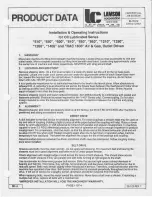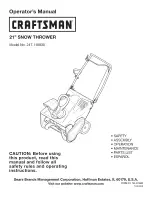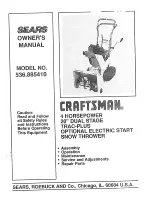
10
Centrifugal Single-Width Blower
®
WARNING
Before taking any corrective action, make certain
unit is not capable of operation during repairs.
Troubleshooting
Problem
Cause
Corrective Action
Excessive Noise
Wheel Rubbing Inlet
Adjust wheel and/or inlet cone.
Tighten wheel hub or bearing collars on shaft.
V-Belt Drive
Tighten sheaves on motor/fan shaft. Adjust belt tension.
Align sheaves properly (see procedure).
Replace worn belts or sheaves.
Bearings
Replace defective bearing(s). Lubricate bearings.
Tighten collars and fasteners.
Wheel Unbalance
Clean all dirt off wheel. Check wheel balance.
Low CFM
Fan
Check wheel for correct rotation.
Duct System
Higher pressure than design. Filters need replacement.
High CFM
Fan
Decrease fan speed.
Duct System
Resize ductwork. Access door, filters, dampers not
installed.
Static Pressure Wrong
Duct system has more
or less restriction than
anticipated
Remove obstructions in system. Use correction factor to
adjust for temperature/altitude. Resize ductwork. Clean
filters/coils. Change fan speed.*
High Motor Amp Draw
Fan
Check rotation of wheel. Reduce fan speed.
Duct System
Resize ductwork. Check proper operation of isolation and
bypass dampers. Check filters and access doors.
Fan Doesn’t Operate
Electrical Supply
Check fuses/circuit breakers. Check for switches turned
off or disconnected. Check for correct supply voltage.
Drive
Check for broken belts. Tighten loose pulleys.
Motor
Assure motor is correct horsepower and not tripping
overload protector.
Overheated Bearing
Lubrication
Check for excessive or insufficient grease in the bearing.
Mechanical
Replace damaged bearing. Relieve excessive belt tension.
Align bearings. Check for bent shaft.
Excessive Vibration
Belts
Adjust tightness of belts. Replacement belts should be a
matched set.
System Unbalance
Check alignment of shaft, motor and pulleys. Adjustable
pitch pulleys with motors over 15 hp are especially
prone to unbalance. Check wheel balance, rebalance if
necessary.
* Always check motor amps and compare to nameplate rating. Excessive fan speed may overload the motor
and result in motor failure. Do not exceed the maximum cataloged rpm of the fan.






























